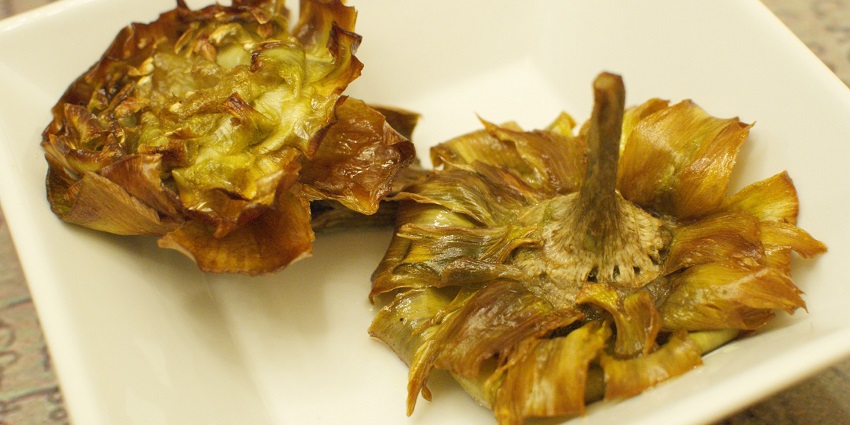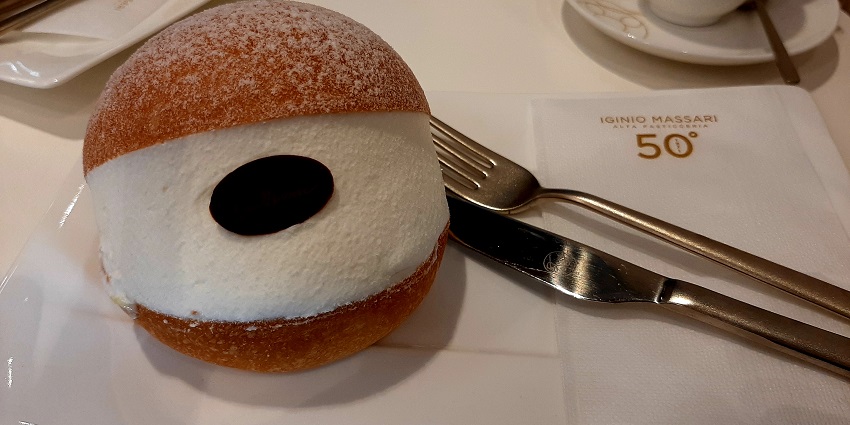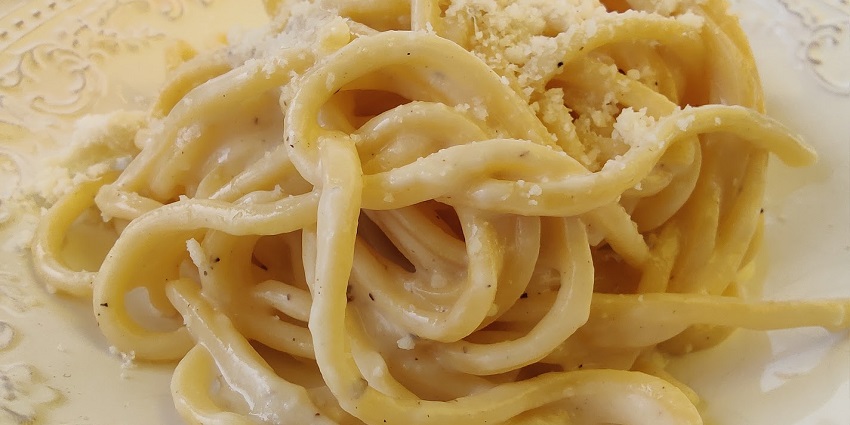Street food in Rome is more than just a quick snack; it’s a delicious window into the city’s rich culinary history. From the delicious Maritozzi to the Crunchy Suppli and Buttery Pizza Al Taglio, every food in Rome, Italy, offers a tale of the city. There are delicious treats wherever you turn, whether in crowded piazzas or hidden alleys. Because it blends innovation and tradition to give you a true taste of the Eternal City, one mouthful at a time, Rome’s street food culture is perfect for foodies on the go.
Top 10 Best Street Foods In Rome
Rome is renowned for its flavorful cuisine. These are ten of the greatest street dishes that are frequently encountered in Rome and are notable for their flavorful look and taste:
1. Pizza al Taglio

Photo: JIP / Wikimedia Commons
Another name for it is pizza by the slice. Pizza isn’t usually circular in Rome. The greatest street food in Rome is pizza al taglio, which is made in the shape of a rectangular sheet pan. It is sold by weight and baked in big trays. Both residents and visitors agree that this is the best street food. In contrast to Naples’ thin wood-fired pizzas, this pizza has a thick, airy crust that is light on the interior and crunchy on the bottom thanks to a long fermentation process. Romans typically pick up a couple of different slices to mix and match.
Top Eateries To Visit: Bonci, Forno Campo de’ Fiori, Pizzarium
Typical Variations: Ricotta and spinach, broccoli rabe and sausage
2. Suppli

Photo: FrederikBianko / Wikimedia Commons
It is sometimes called the Roman Risotto Ball. Suppli is the only meal that perfectly embodies the Romans’ love of comfort food in a little, bite-sized amount. It is a high-quality street dish made of a deep-fried rice ball stuffed with mozzarella and ragu, or meat sauce. Additionally, bread crumbs are used to cover it, and it is cooked till golden brown. The reason it’s called “Suppli al telefono” is that when you split it apart, the melted cheese spreads out like telephone cables. It is the ideal grab-and-go choice for walking past Roman ruins or when enjoying a pizza and a beer because of its robust, rich, and nostalgic flavor.
Top Eateries To Visit: Supplizi, La Casa del Suppli, Trappizzino and Pizzarium
Typical Variations: Suppli al telefeno (classic with ragu and mozzarella)
3. Porchetta

Photo: Andy Li / Wikimedia Commons
It is roasted pork packed with herbs. Porchetta, a beautifully grilled pork bun seasoned with salt, black pepper, fennel, rosemary, and garlic, is a traditional Roman street food. Originally from the countryside outside Rome, it has become a popular street food staple in the capital. You must debone a whole pig, season it from the inside out, roll it securely, and gently roast it until the skin is crispy. The street food form of porchetta is typically served as a panino con porchetta, which is a crispy bun filled with slices of the savory pork that are occasionally topped with some roasted veggies or a smear of spicy mustard. However, porchetta can also be eaten as part of a sit-down dinner.
Top Eateries To Visit: Er Buchetto, Panificio Bonci, La Norcineria di iacozzilli and Porchetta Truck
Typical Variations: Classic with fennel and garlic, Porchetta with chilli oil
4. Carciofi alla Giudia

Photo: Marco Iannantuoni / Wikimedia Commons
Roman-Jewish artichokes are crunchy. The historic Jewish Ghetto is where this well-known Roman street cuisine first appeared. Jewish-style artichokes, or carciofi alla Giudia, are a treasure trove of Roman street food. This dish, which dates back centuries, shows how Roman-Jewish cuisine transformed an ordinary vegetable into a delectable deep-fried delight. Whole Romanesco artichokes are well cleaned, then twice-fried until crisp, then gently pounded to release their leaves in the shape of a flower. The first fry softens the stem and heart, while the second fry adds a tantalising crunch. These are quite pleasant, eaten by hand, and gently seasoned with salt and lemon. As you go through the Ghetto neighborhood, the nutty aroma of sizzling olive oil and roasted artichokes lets you know you’re approaching a local treasure. Although some people eat this meal all year round, it is usually accessible from February to May.
Top Eateries To Visit: Nonna Betta, Da Giggetto, Sora Margherita and Ba’ Ghetto
Typical Variations: Traditional (fried with olive oil, lemon). Carciofi alla Romana
5. Maritozzo

Photo: Asdalol / Wikimedia Commons
Maritozzo, a delicious, fluffy brioche bun cut and packed with fresh whipped cream, has been a Roman favorite since ancient times. During Lent, Romans used to gift these delicacies to their lover; some even placed engagement rings within! These days, it’s a midmorning treat or a breakfast regular. The dough is light, delicate, and gently seasoned with honey or orange zest. Because of its grab-and-go format, it qualifies as street food in Rome. They may be seen in Rome’s top street food establishments and are often spotted with a cappuccino in one hand and a maritozzo in the other. It is ideal to eat maritozzo fresh, within hours after making it, since the cream starts to soak into the bun, giving it a cloud-like aspect.
Top Eateries To Visit: Trapizzino, Supplizio and Trapizzino at Mercato Centrale
Typical Variations: Pollo alla cacciatora (chicken cacciatore), Polpetta al sugo
6. Tonnarelli Cacio e Pepe

Photo: Camelia.boban / Wikimedia Commons
It’s a street-style Roman spaghetti. Pasta may not appear to be a traditional street snack, but Tonnarelli Cacio e Pepe, a meal that can be served in ecologically friendly containers, is becoming increasingly popular. Making this famous Roman meal with only three ingredients, black pepper, Pecorino Romano, and Tonnarelli (a thicker spaghetti), is the embodiment of “less is more”. Cheese is emulsified with pasta water and freshly crushed pepper to make a creamy sauce rather than cream. It’s almost fascinating seeing the cheese melt into the pasta in front of you. Some fill the top layer with caramelised crunch, while others use truffle shavings or flavoured cheeses for a modern twist.
Top Eateries To Visit: Pastificio Guerra, Trapizzino, Pasta Chef and Tonnarello
Typical Variations: With truffle oil or shaved truffles
7. Filetti di Baccala

Photo: Juan Emilio Prades Bel / Wikimedia Commons / Image For Representation Only
Filetti di Baccala, or fried salt cod, is Rome’s version of fish and chips that is lighter and tastier, with a crispy surface and a soft center. After soaking to remove excess salt, these salted cod fillets are covered in a simple flour-based batter and deep-fried till golden. The end result is a crispy, somewhat oily surface with a flake-tender middle that is best eaten straight out of the fryer. It is usually served with a lemon slice and some fried zucchini flowers on the side, wrapped in paper. This delicacy, which developed when salt cod was a cheap protein, is especially common in the Jewish Ghetto and Trastevere. During holidays such as Christmas and Fridays, many Italians will. People on holidays such as Christmas and Fridays, when many Italians avoid meat, and these fillets are a must-try for seafood enthusiasts.
Top Eateries To Visit: Dar Filettaro in Santa Barbara, Nonna Betta, Supplizio and II Ghetto Fish
Typical Variations: Served with fried zucchini blossoms
8. Gelato Artigianale

Photo: rawpixel / Wikimedia Commons
This is authentic Italian ice cream. Without Gelato Artigianale, no list of Roman street snacks is complete. Compared to its American counterpart, this arsenal ice cream is creamier, thicker, and more flavorful. Artisanal gelato, which is created fresh every day with natural ingredients and is airtight, has a rich flavor and a smooth texture. Every scoop is a culinary journey, whether it contains Piedmont hazelnuts, Sicilian pistachios, or seasonal fruits. There are various gelaterias in Rome that provide both classic and inventive delicacies including prosecco sorbet, salted caramel, and ricotta and fig. Gelato is a year-round treat that can be enjoyed in a cup or cone. It is amazing since the use of natural colors and components is careful. Gelato is a year-round treat that can be enjoyed in a cup or cone.
Top Eateries To Visit: Gelateria del Teatro, Fatamorgana, Frigidarium, La Romana
Typical Variations: Pistachio and hazelnut and stracciatella, vegan coconut
9. Panino con Lampredotto

Photo: Lucarelli / Wikimedia Commons / Image For Representation Only
It’s a Roman Tuscan Fusion favourite. Despite originating from Florence, Lampredotto has gained popularity in Rome’s culinary scene, notably at food trucks and markets serving Tuscan-inspired meals, and can be found on Rome’s top non-vegetarian street. This dish, produced from the cow’s fourth stomach, exemplifies Italy’s passion for using every part of the animal. This meal is more of a culinary secret in Rome, where discerning travelers seek it out as the tastiest street food in town. The taste is robust, meaty, and well-seasoned, while the texture is soft but chewy. It has a supple but chewy texture and a robust, meaty flavor that is appropriately seasoned. If you like experimental dining, this meal is for you.
Top Eateries To Visit: Mercato centrale, Mordi & Vai, Panino Divino
Typical Variations: With salsa verde, spicy tomato sauce
10. Crispelle

Photo: David Monniaux / Wikimedia Commons / Image For Representation
Despite being usually associated with southern Italy, Crispelle has established a comfortable presence in Rome’s street food scene, notably during holidays and neighborhood fairs. These are savory or sweet deep-fried dough fritters, making them a filling and versatile snack. Consider hot, tasty balls of golden-brown dough that are fluffy on the inside and somewhat crunchy on the outside. They are very popular at winter fairs and around Christmas. Rice-filled fritters, also known as Crispelle di Riso, are prepared with cooked rice and flavored with sugar, honey, and orange zest. They serve a warm, sticky-sweet delicacy that is both festive and comforting. They are portable and perfect for munching on when taking a leisurely stroll in the evening or exploring cobblestone alleyways.
Top Eateries To Visit: Forno Campo de’ Fiori, Panificio Bonci
Typical Variations: Crispelle di Riso, Crispelle con Alici, Mozzarella-filled Crispelle
More than just fast nibbles, street food in Rome is a flavorful journey through the city’s past, present, and culture. Every dish, from the crispy edges of a golden Supplì to the lovely aroma of a Maritozzo, has a background that has been developed over many generations on crowded piazzas and cobblestone streets. Whether you’re wandering past the Colosseum or hiding down in a Trastevere lane, there’s always a wonderful surprise nearby.
Cover Photo: Engin Akyurt / Pexels


 WhatsApp
WhatsApp
 Twitter
Twitter









